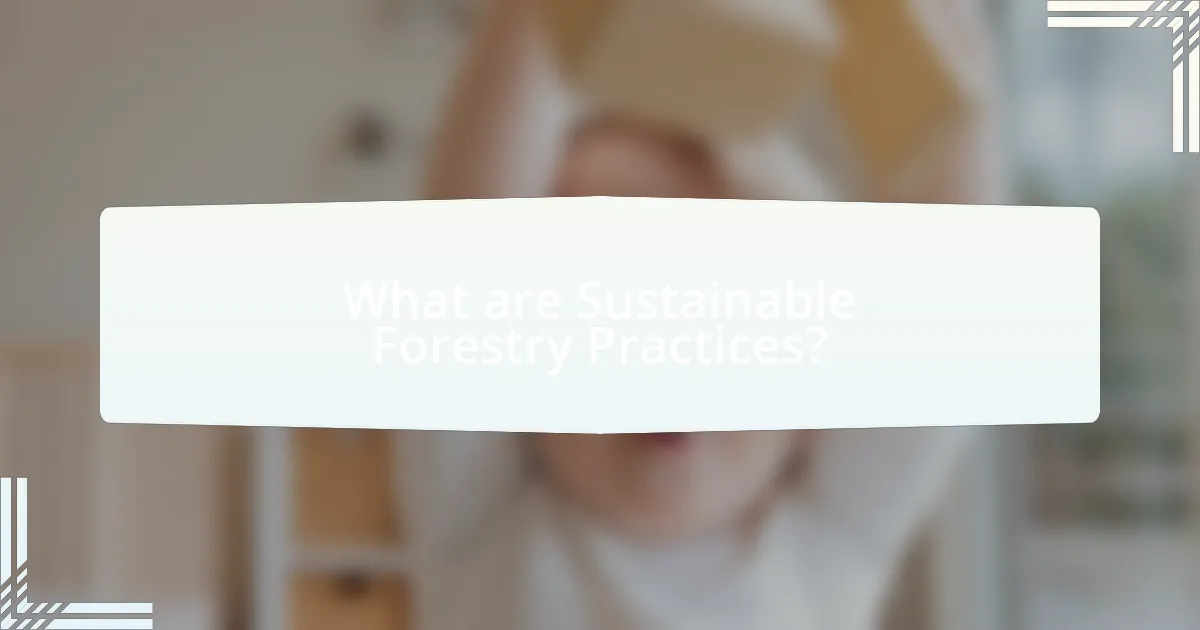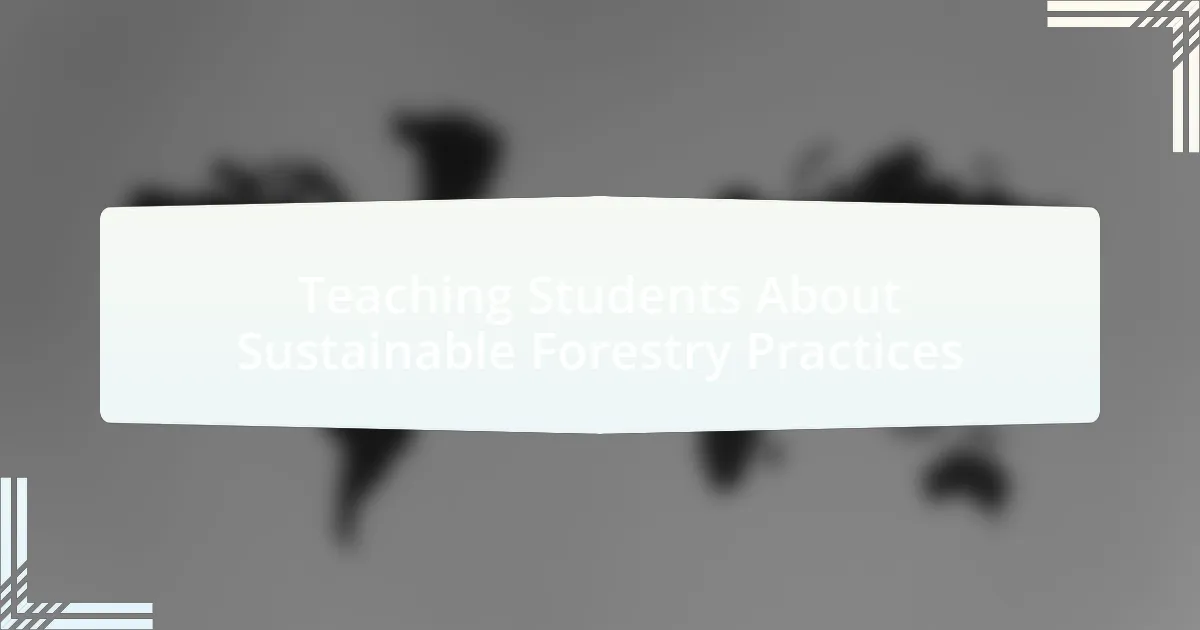The article focuses on teaching students about sustainable forestry practices, which are essential methods for managing forest resources to meet current needs without compromising future generations. It outlines the importance of sustainable forestry for environmental health, biodiversity, and carbon sequestration, emphasizing key principles such as maintaining forest health and promoting social and economic benefits. The article also discusses effective educational strategies, including hands-on activities, field trips, and the integration of technology, to enhance student engagement and understanding of sustainable forestry. Additionally, it addresses challenges educators face and offers best practices for effectively conveying the significance of sustainable forestry to students.

What are Sustainable Forestry Practices?
Sustainable forestry practices are methods of managing forest resources that meet current needs without compromising the ability of future generations to meet their own needs. These practices include selective logging, reforestation, maintaining biodiversity, and protecting water quality. For instance, the Forest Stewardship Council (FSC) certifies forests that adhere to sustainable management principles, ensuring that logging activities do not exceed the forest’s natural regeneration capacity. Additionally, studies show that sustainable forestry can enhance carbon sequestration, contributing to climate change mitigation while supporting local economies and ecosystems.
Why is Sustainable Forestry Important for the Environment?
Sustainable forestry is important for the environment because it ensures the long-term health and biodiversity of forest ecosystems while meeting human needs. This practice minimizes deforestation and habitat destruction, which are critical for maintaining carbon storage, water quality, and soil health. According to the Food and Agriculture Organization, sustainable forest management can help mitigate climate change by sequestering carbon dioxide, with forests absorbing approximately 2.6 billion tons of CO2 annually. Additionally, sustainable forestry practices promote the regeneration of tree species and protect wildlife habitats, thereby preserving biodiversity.
How do Sustainable Forestry Practices Contribute to Biodiversity?
Sustainable forestry practices contribute to biodiversity by maintaining ecosystem health and promoting species variety. These practices, such as selective logging and maintaining buffer zones, help preserve habitats for various flora and fauna. For instance, a study published in the journal “Forest Ecology and Management” found that forests managed sustainably can support up to 30% more species compared to those subjected to conventional logging methods. By minimizing habitat destruction and ensuring the regeneration of native species, sustainable forestry fosters a balanced ecosystem that enhances overall biodiversity.
What Role Does Carbon Sequestration Play in Sustainable Forestry?
Carbon sequestration plays a crucial role in sustainable forestry by capturing and storing atmospheric carbon dioxide in trees and soil, thereby mitigating climate change. This process enhances forest health and productivity, as trees absorb CO2 during photosynthesis, converting it into biomass. According to the Intergovernmental Panel on Climate Change (IPCC), forests globally sequester approximately 2.6 billion metric tons of carbon annually, highlighting their significance in reducing greenhouse gas concentrations. Sustainable forestry practices, such as selective logging and reforestation, further promote carbon storage by maintaining forest ecosystems and increasing biodiversity, which collectively contribute to long-term carbon sequestration efforts.
What Are the Key Principles of Sustainable Forestry?
The key principles of sustainable forestry include maintaining forest health, ensuring biodiversity, and promoting social and economic benefits. Maintaining forest health involves practices that protect soil, water, and wildlife habitats, which are essential for ecosystem balance. Ensuring biodiversity means managing forests to support a variety of species, which enhances resilience against pests and diseases. Promoting social and economic benefits focuses on providing livelihoods for local communities while ensuring that forest resources are used responsibly. These principles are supported by guidelines from organizations such as the Forest Stewardship Council, which emphasizes responsible management practices that meet the needs of present and future generations.
How Does Sustainable Yield Affect Forest Management?
Sustainable yield directly influences forest management by ensuring that timber and non-timber resources are harvested at a rate that maintains the forest’s ecological balance. This approach prevents over-exploitation, allowing forests to regenerate naturally and sustain biodiversity. For instance, the concept of sustainable yield is often quantified through metrics such as the Maximum Sustainable Yield (MSY), which indicates the largest yield that can be taken from a specific area without compromising its future productivity. Research shows that forests managed under sustainable yield principles can maintain their health and productivity over time, as evidenced by studies indicating that sustainably managed forests can produce 20-30% more timber over a rotation period compared to those subjected to unsustainable practices.
What Practices Ensure Forest Health and Resilience?
Practices that ensure forest health and resilience include sustainable logging, reforestation, and biodiversity conservation. Sustainable logging minimizes environmental impact by adhering to guidelines that prevent overharvesting and maintain ecosystem balance. Reforestation involves planting trees to restore degraded areas, which enhances carbon sequestration and habitat restoration. Biodiversity conservation protects various species and their habitats, promoting ecosystem stability and resilience against pests and diseases. Research indicates that forests with higher biodiversity are more resilient to climate change and disturbances, as diverse ecosystems can better withstand and recover from environmental stressors.
How Can Students Learn About Sustainable Forestry Practices?
Students can learn about sustainable forestry practices through hands-on experiences, educational programs, and research initiatives. Engaging in field trips to forests, participating in tree planting activities, and collaborating with local forestry organizations provide practical insights into sustainable methods. Additionally, academic courses focused on environmental science or forestry often include modules on sustainability, covering topics such as ecosystem management and conservation techniques. Research studies, such as those published in the Journal of Forestry, highlight the effectiveness of experiential learning in enhancing students’ understanding of sustainable practices.
What Educational Resources Are Available for Teaching Sustainable Forestry?
Educational resources available for teaching sustainable forestry include online courses, textbooks, interactive websites, and educational programs from organizations like the Forest Stewardship Council and the U.S. Forest Service. Online platforms such as Coursera and edX offer courses on sustainable forestry practices, while textbooks provide foundational knowledge on forest ecology and management. Interactive websites, like the Sustainable Forestry Initiative, offer lesson plans and activities tailored for educators. Additionally, organizations often provide workshops and field trips that enhance hands-on learning experiences. These resources collectively support educators in effectively teaching sustainable forestry principles.
How Can Hands-On Activities Enhance Understanding of Sustainable Forestry?
Hands-on activities enhance understanding of sustainable forestry by providing experiential learning opportunities that engage students directly with forest ecosystems. These activities, such as tree planting, forest management simulations, and biodiversity assessments, allow students to apply theoretical knowledge in real-world contexts, fostering deeper comprehension of ecological principles and sustainable practices. Research indicates that experiential learning can improve retention rates and critical thinking skills; for instance, a study published in the Journal of Environmental Education found that students participating in hands-on activities demonstrated a 30% increase in knowledge retention compared to traditional learning methods. This direct interaction with the environment not only solidifies academic concepts but also cultivates a sense of stewardship and responsibility towards forest conservation.
What Challenges Do Educators Face in Teaching Sustainable Forestry?
Educators face several challenges in teaching sustainable forestry, including a lack of resources, insufficient training, and varying levels of student engagement. Limited access to up-to-date materials and technology can hinder effective teaching, as educators may struggle to provide current information on sustainable practices. Additionally, many educators may not have received specialized training in forestry or sustainability, which can affect their confidence and ability to convey complex concepts. Furthermore, students’ varying interests and backgrounds can lead to differing levels of engagement, making it difficult for educators to maintain a consistent learning environment. These challenges highlight the need for improved support and resources in forestry education.
How Can Educators Overcome Misconceptions About Forestry Practices?
Educators can overcome misconceptions about forestry practices by implementing hands-on learning experiences and integrating accurate information into their curricula. Engaging students in field trips to forests or tree farms allows them to observe sustainable practices in action, fostering a deeper understanding of ecological balance. Additionally, utilizing resources from reputable organizations, such as the U.S. Forest Service, which provides data on sustainable forestry benefits, can help clarify common myths. For instance, studies show that sustainable forestry can enhance biodiversity and improve forest health, countering the belief that logging is inherently harmful. By combining experiential learning with factual resources, educators can effectively dispel misconceptions and promote informed perspectives on forestry practices.
What Strategies Can Be Used to Engage Students in Sustainable Forestry Topics?
Interactive learning strategies, such as hands-on activities, field trips, and project-based learning, can effectively engage students in sustainable forestry topics. These methods allow students to experience real-world applications of sustainable practices, fostering a deeper understanding of ecological principles. For instance, field trips to local forests or tree nurseries can provide students with firsthand observations of forestry management techniques, while project-based learning can involve students in creating sustainable forestry plans for their communities. Research indicates that experiential learning significantly enhances student engagement and retention of information, making these strategies particularly effective in teaching complex environmental topics.
What Are Effective Methods for Teaching Sustainable Forestry Practices?
Effective methods for teaching sustainable forestry practices include hands-on learning experiences, interactive workshops, and the integration of technology. Hands-on learning allows students to engage directly with forestry environments, fostering a deeper understanding of ecological principles. Interactive workshops can facilitate discussions on sustainable practices, enabling students to collaborate and share ideas. The use of technology, such as simulation software and online resources, enhances learning by providing real-time data and visualizations of forestry management scenarios. Research indicates that experiential learning approaches significantly improve retention and application of sustainable practices among students, as evidenced by studies conducted by the National Association of State Foresters, which highlight the effectiveness of practical engagement in environmental education.
How Can Technology Be Integrated into Sustainable Forestry Education?
Technology can be integrated into sustainable forestry education through the use of digital tools such as Geographic Information Systems (GIS), remote sensing, and online learning platforms. GIS allows students to analyze spatial data related to forest management, enabling them to visualize and understand the impact of various practices on ecosystems. Remote sensing technology provides real-time data on forest health and biodiversity, which enhances students’ ability to make informed decisions regarding sustainable practices. Online learning platforms facilitate access to a wide range of resources, including interactive simulations and virtual field trips, which can enrich the educational experience. Research indicates that incorporating these technologies not only improves engagement but also enhances the retention of knowledge among students in forestry programs.
What Role Do Field Trips Play in Understanding Sustainable Forestry?
Field trips play a crucial role in understanding sustainable forestry by providing hands-on experiences that enhance learning. These excursions allow students to observe forest ecosystems, engage with forestry professionals, and witness sustainable practices in action, which deepens their comprehension of ecological principles. Research indicates that experiential learning, such as field trips, significantly improves retention of information and fosters a connection to environmental stewardship. For instance, a study published in the Journal of Environmental Education found that students who participated in field-based learning demonstrated a 30% increase in knowledge retention compared to traditional classroom settings. This evidence underscores the effectiveness of field trips in promoting a practical understanding of sustainable forestry practices.
What Best Practices Should Educators Follow When Teaching Sustainable Forestry?
Educators should incorporate experiential learning, interdisciplinary approaches, and community engagement when teaching sustainable forestry. Experiential learning allows students to participate in hands-on activities, such as tree planting and forest management simulations, which enhance understanding of ecological principles. Interdisciplinary approaches integrate subjects like biology, economics, and social studies, providing a holistic view of forestry’s impact on ecosystems and communities. Community engagement involves collaboration with local forestry professionals and organizations, offering students real-world insights and fostering a sense of responsibility towards sustainable practices. These methods are supported by research indicating that active participation and real-world connections significantly improve student retention and understanding of complex environmental issues.

Leave a Reply